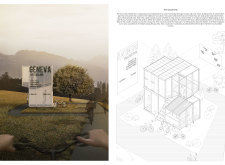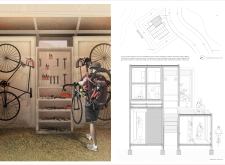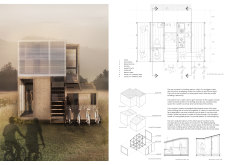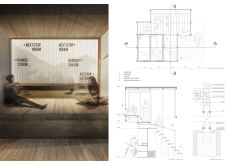5 key facts about this project
The design is characterized by its open layout, allowing for an abundance of natural light to permeate through expansive windows. This openness fosters a sense of spaciousness, which is essential for the project's function. The architecture effectively supports its intended purpose, be it residential, commercial, or recreational, by providing flexible spaces that can adapt to a range of activities. The careful planning of spatial relationships enhances the user experience, ensuring that each area serves its designated purpose while contributing to the overall harmony of the setting.
Materials play a crucial role in the project’s conception. The use of sustainable materials such as reclaimed wood, steel, and glass not only emphasizes the commitment to environmental responsibility but also enriches the aesthetic quality of the structure. The choice of these materials speaks to a larger narrative about the interplay between durability and beauty, where functionality does not come at the expense of visual appeal. The textures and colors of the materials complement one another, creating a cohesive aesthetic that resonates with the surrounding landscape.
A notable aspect of the architecture is its unique approach to blending indoor and outdoor environments. The incorporation of large sliding doors and strategically placed terraces heightens the relationship with nature. These elements facilitate a flow between the interior and exterior spaces, blurring the boundaries and creating areas for outdoor gatherings and contemplation. The design encourages occupants to engage with their environment in a manner that promotes well-being and connection to nature.
Unique architectural ideas are evident in the project's design, particularly in the way it addresses light and ventilation. The thoughtful placement of windows and overhangs allows for effective natural cooling and lighting, reducing reliance on artificial systems. This design approach not only contributes to energy efficiency but also enhances the overall comfort of the building's users. Additionally, vertical gardens or green walls may be incorporated within the framework, further accentuating the connection to nature while improving air quality.
Landscaping also plays a pivotal role in the project, as outdoor spaces are designed to harmonize with the overall architecture. The inclusion of native plants and pathways that encourage exploration enriches the experience of the environment while providing a backdrop for the building itself. The landscaping is not merely an aesthetic choice but serves functional purposes, such as managing rainwater runoff and providing habitats for local wildlife.
The project further emphasizes social engagement through common areas that encourage community interaction. These spaces are thoughtfully designed to be inviting and accessible, fostering a sense of belonging among users. Whether through shared gardens, communal gathering areas, or multi-purpose rooms, the architecture promotes collaboration and enhances community relationships.
In discussing the uniqueness of this architectural design project, it is evident that every element has been meticulously considered, from the selection of materials to the arrangement of spaces. This comprehensive approach not only reflects an understanding of the practical needs of its users but also illustrates a commitment to creating a harmonious and sustainable environment.
For those interested in deeper insights into the project, exploring architectural plans, sections, and designs will provide a fuller understanding of the intricate details and thoughtful decisions that define this architecture. This opportunity to delve into the various aspects of the project's design reveals the richness and complexity that such an undertaking embodies, inviting readers to appreciate the careful craftsmanship and innovative thinking that have come together to create a truly thoughtful architectural endeavor.


























